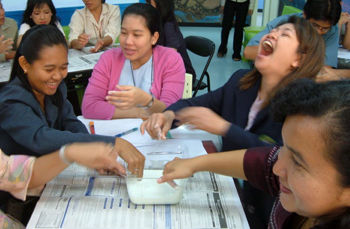
COMMUNICATING SCIENCE © 2011 the Regents of the University of California

In this session, we address “what is science,” and “how does science work?” Participants gain insight into the nature and practices of science in the best way possible—by doing and reflecting on science.
— After an introductory brainstorm about “What is science?” participants investigate a strange substance called “Oobleck,” and then, using the evidence they’ve gathered, make generalizations about the substance, and derive “Laws of Oobleck.” This turns out to be much more complex than they may have imagined!
— The experience provides a sense of the actual practices involved in doing science and helps communicate the nature of science as an evidence-driven human endeavor to investigate, find out about, understand, and make generalizations about the natural world.
— Participants also take a critical look at what is and is not an accurate view of science. These misinterpretations, conscious and unconscious, are widespread, and examining them can help hone our own understanding of what science is and is not. Through attempting to define science, participants can gain a deeper understanding of its strengths and limitations.
— Tinker and Thornton describe science: “ …not as a noun...but as a process, a set of activities, a way of proceeding and thinking.”
Not all of us learned science in this way; some of us needed to wait until graduate school to become authentically engaged with doing science. And yet, as is illustrated through the Oobleck experience in this session, science can be introduced to the youngest of students in ways that engage them in the firsthand collection and evaluation of evidence.